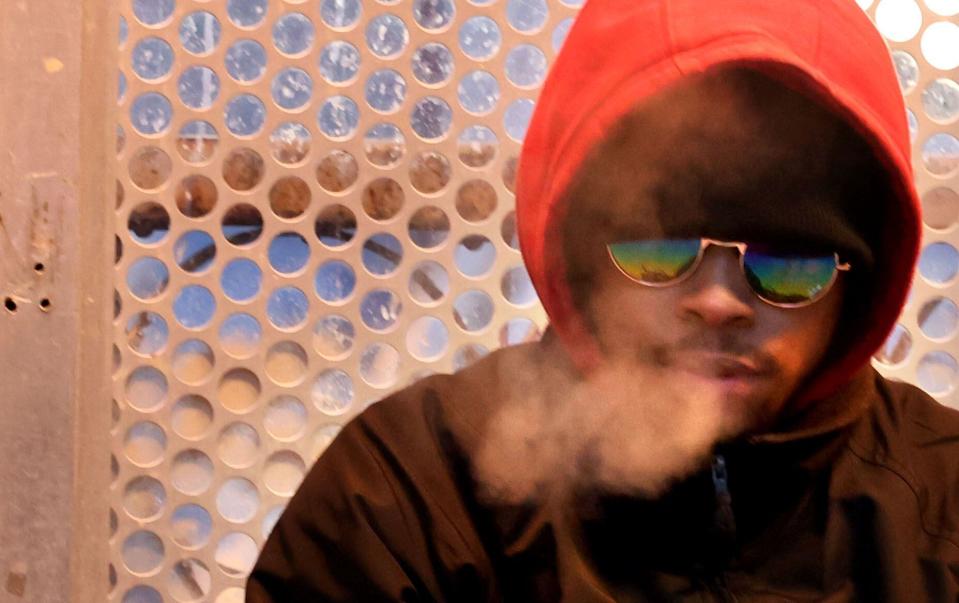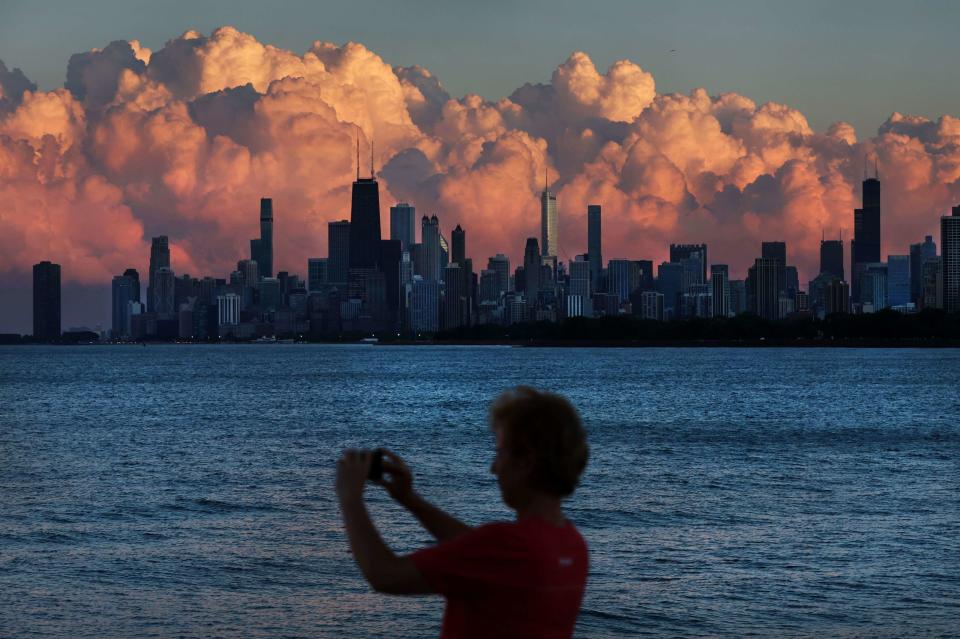Chicago weather: The hottest, coldest, wettest and snowiest days of 2023
- Oops!Something went wrong.Please try again later.
Chicago experienced tornadoes in February and March, multiple rounds of severe storms in April, flash floods in July and September, and a lack of snowfall to end 2023.
Here’s a look at the most extreme days in Chicago weather this year, with insights by the National Weather Service’s Chicago office and Trent Ford, Illinois state climatologist.
Hottest: 100 degrees
Aug. 24, 2023
Temperatures at or above the century mark are a rarity in Chicago.
Yet 100 degrees was recorded this year for the first time in more than a decade at O’Hare International Airport, the city’s official recording site. It capped two days of excessive heat across the area, with peak heat indexes greater than 115 degrees. It was the first time this occurred since the deadly heat wave of July 1995.
A high temperature of 98 degrees was observed on Aug. 23 — a new record high for the date. It was followed by the 100-degree mark observed on Aug. 24, which tied the record high for that date, according to the National Weather Service.
The heat caused some schools to close, the cancellation of outdoor sports, recess and activities, and kept many people inside apart from a few brave tourists visiting Grant Park.
How it compares historically
That makes just 66 days, when looking back through more than 136 years of data kept by the weather service, that have logged triple-digit temperatures.
The highest temperature on record in Chicago was 105 degrees logged on July 24, 1934, but unofficial results have been even more extreme. Documented highs of 109 degrees during the Dust Bowl in 1934 and 106 during an oppressive heat wave in 1995 were set at other sites in the city.
Coldest: Minus 1 degree
Jan. 31, 2023, and Feb. 3, 2023
Low temperatures bottomed out in negative single digits just twice this year — within a few days of each other.
But the coldest days of meteorological winter 2022-23 happened last year. An arctic blast of below-zero temperatures and bitter wind chills forced the cancellation of some of the city’s much-loved holiday attractions and produced one of the coldest Bears home games on Dec. 23, 2022, when the low temperature was minus 8 degrees.
Overall, the period from Dec. 1, 2022, to the end of February 2023 was the city’s fourth warmest in the last 70 years and the 14th warmest since records began in 1872, according to state climatologist Ford.
Ford said a relatively balmy average winter temperature of 31.8 degrees at O’Hare International Airport was due in part to climate change, but naturally occurring weather patterns played a part as well.
“(Warm weather) in any given month, season or year is never just because of climate change,” said Ford, who pointed out that some of the city’s warmest winters were in the late 19th century.
How it compares historically
It’s been much colder.
Eight of the coldest temperatures and seven of the largest snowfalls ever recorded here happened in January.
The city experienced a day of frostbite, fuming motorists and freezing homes on Jan. 20, 1985, when the temperature plummeted to minus 27 degrees — the coldest day on record in Chicago.
Tom Skilling, WGN-TV’s chief meteorologist, who will retire at the end of February, remembered the time he had to push his car into a garage behind the station to warm it up during one brutally cold winter.
“They used to do Bert Weinman Ford commercials in that garage so they had a big turntable that they put the cars on as the announcer told you about the latest deal. Well, that’s the same garage into which we pushed my car and after a couple of hours, I could finally get it going again. But, oh, it was just awful!
“The atmosphere took on a very almost unworldly state at that point,” Skilling told the Tribune earlier this year.
Wettest: 3.35 inches
July 2, 2023
Three to eight inches of rain fell around the area, but the official total broke Chicago’s previous July 2 daily rainfall record of 2.06 inches set in 1982. It was also the highest daily rainfall recorded at O’Hare since May 14, 2020, according to the National Weather Service.
Thunderstorms wreaked havoc across Chicago, resulting in flooding the weather service described as “potentially life-threatening,” swamping highways, halting some Chicago Transit Authority services and damaging dozens of homes.
Torrential rains also put a damper on the first NASCAR Chicago Street Race as standing water covered parts of the course and fans waited in the rain for the races to resume. NASCAR officials declared Cole Custer the winner of the Xfinity Series Race on Sunday, July 2, after lightning forced officials to shut it down with just under half the laps completed.
The 4:05 p.m. start of the main event — the NASCAR Cup Series Grant Park 220 — was delayed more than an hour as race officials waited for the rain to move out of the area.
How it compares historically
Chicago’s heaviest rainfall on record at O’Hare for a 24-hour span was 9.35 inches on Aug. 13-14, 1987. If that rain had been snow, according to the National Weather Service, then Chicago and its northern suburbs would have been buried under 93 inches, or about as much as during the entire infamous winter of 1979, when it took several weeks to accumulate that amount.
The landmark rainfall from 1987 made it easier to get to O’Hare from Los Angeles than from downtown Chicago. The trip from the West Coast took only about four hours; the trip from downtown Chicago took 9 hours, 15 minutes for a Westin Hotel bus, according to the Tribune’s archives.
Normally, Chicago receives 3.71 inches of rain during the month of July.
Snowiest: 3.6 inches
Jan. 25, 2023
The only significant thing about last winter’s snowfall was its absence.
Just 18 inches of snow fell at O’Hare — roughly 20 inches below normal. Why was snow scarce? Chicago was warmer than average during the 2022-23 season due to a La Nina climate system.
The city typically experiences about two days with a snowfall greater than 6 inches between December and February, National Weather Service meteorologist Brett Borchardt told the Tribune, but that didn’t happen at all last winter.
A daily snowfall of 1 inch or more was recorded just seven times during the 89-day season.
Though snowfall was lacking, Chicago had more rain than expected.
How it compares historically
Chicago’s largest single snow event began with flakes falling at 5:02 a.m. on Jan. 26, 1967, and didn’t stop until a record-breaking 23 inches had accumulated the next day. Mountains of snow accumulated in drifts, whipped by winds of 50 mph or more.
Many commuters were stuck at their workplaces on Jan. 26 as a result of the snow, staying there or at a nearby hotel for the night.
In Chicago alone, an estimated 20,000 cars and 1,100 Chicago Transit Authority buses were stranded in the snow, according to the weather service. More than 2,500 people and 500 pieces of equipment would be used in the ensuing days to dig out the roads. The airports were also closed and passengers stuck inside terminals were provided pillows, blankets and hot coffee as crews outside worked to clear runways.
Remarkably, the storm was preceded by unseasonable warmth — it was 65 degrees just two days before the snow appeared.
The most snow Chicago has ever received in one season is 89.7 inches during 1978-79. The least — 9.8 inches — occurred in 1920-21.
Sources: Tribune reporting and archives; National Weather Service Chicago
Join our Chicagoland history Facebook group and subscribe to the Vintage Chicago Tribune newsletter for more from Chicago’s past.





